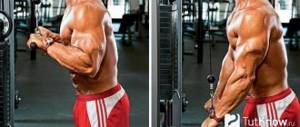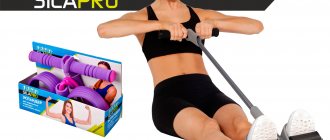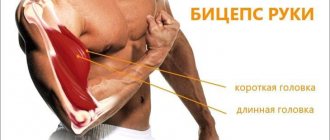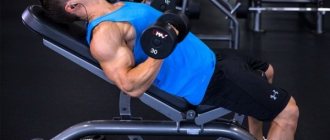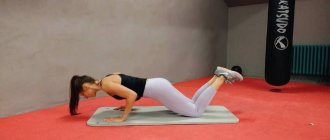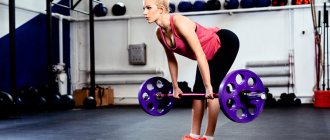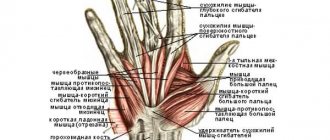A well-balanced, developed and beautiful body is the main criterion for assessing an athlete in bodybuilding. Even the smallest muscle groups should be pumped up, developed, and proportional. This also applies to the forearms. Many bodybuilders neglect this small muscle group or completely ignore it.
Biceps workouts involve the forearms well, but do not guarantee that they will “keep up” with the rest. If your forearms lag behind, then additional load is needed. When you don’t have enough time planned for training in the gym, you can pump up your forearms at home. The only sports equipment you will need is dumbbells, but it is better to also have a barbell at your disposal.
Anatomy of arm muscles
The arm muscles have many large, visible muscles that help us with everyday activities, such as changing clothes or lifting weights.
The complex design of the forearms allows us to perform completely different movements of our hands. Our fingers are also amazingly designed to allow us to grip barbells and dumbbells. All parts of the forearm, hand, fingers interact so harmoniously with each other that it is a real ensemble of bones, ligaments and tendons.
34 complex muscles provide varied mobility of our fingers and hands. They are so strong that trained people can support their weight by grasping something with a few fingertips.
| Brachioradialis (brachioradialis muscle) | It is located on the front of the forearm. It starts from the shoulder, or rather from the outer part of it, after which it makes an intersection through the elbow and extends to the radius. Involved in elbow flexion and also helps rotate the forearm up/down. |
| Wrist support | It is thanks to this muscle that we can supinate while pumping the biceps, since it rotates the hand outward. Resembles a thin plate in the shape of a triangle. It is attached from our elbow to the thumb side. |
| Extensor carpi radialis longus | Be located next to the brachioradialis on the side of the triceps muscle. Participates in the outward extension of our hand. |
| Flexor carpi radialis and ulnaris | These muscles are visible on the biceps side on the inside of our forearms. They work when you need to bend your hands towards yourself. They also perform pronation of the hand (turn it outward), this is their additional function. |
| Extensors and flexors of the fingers | These muscles are located throughout the forearm, on its outer and inner sides. They provide grip strength, but add little volume. |
| Pronator teres | The main function of this muscle is to turn the hand inward from the side of our little finger. Also involved in forearm flexion. |
| Pronator quadratus | Similar to the round one, but differs in that it has the shape of a plate with four corners and is located next to the palm. |
Just as with the calf muscles, the forearms require frequent and heavy loads. Despite the fact that when working with heavy weights (especially with various rows without wrist belts), the forearms are also involved, it is still better to do special exercises.
How to pump up deltoid muscles
Michael Gundill | Source: Ironman, #27, 2003
Shoulder presses put a huge load on the deltoid muscles. When they are well developed, the shoulders appear wider. Many bodybuilders believe that they can achieve this effect only with dumbbell raises, but presses are much more effective. In addition, you will be able to lift much more weight on the presses.
However, if your triceps are weak, they will hinder your progress. Presses, with the exception of the overhead press, where you lightly stretch the front deltoids, do not stretch the muscle or increase mobility.
A very popular myth is that chest presses load the front deltoids, and overhead presses load the rear deltoids. The idea of using both options is good, but neither of them will do much for the rear deltoids.
Helpful advice!
Make sure you provide a balanced workout to all areas of the deltoids, supraspinatus, and upper back. Consider the following data published by German scientists.
In bodybuilders, the anterior deltoids are on average five times larger than those of ordinary people, the lateral deltoids are three times larger, and the posterior ones are only 10-15%. This imbalance negatively affects the supraspinatus tendons and can lead to shoulder pain.
Important information
Long-term work with free weights is risky and it's not even about the movement itself. An unnatural load is placed on the shoulders when removing and returning the barbell to the stops. Even if you have a training partner to help you with this, you are still putting your shoulders at risk when lifting heavy weights.
Interesting: Pump up shoulders at home for a man
Using a Smith machine is a much safer option because the bar moves in a straight line. You don't have to worry less about maintaining balance and danger in the final reps of a heavy set. As for the shoulder joints themselves, overhead presses put more stress on them than front presses.
In both cases, the wider the grip, the more stress on the joints.
Intensification strategies
If your number one goal is broadening your shoulders, then you can pre-exhaust your deltoids with dumbbell flyes or barbell rows. Once you reach failure, you can either rest or immediately begin pressing. Pre-exhaustion is also suitable for overcoming triceps limitations.
Another way to reduce the involvement of the triceps in the work is post-exhaustion. Complete the presses and immediately move on to front raises on a block or with dumbbells. This ensures maximum fatigue of the anterior deltoids.
Working with Heavy Weights You can easily increase the weight on your bench presses by reducing the range of motion. Instead of lowering the bar all the way down, stop at the top of your head. This amplitude is more physiological, and therefore you can work with heavier weights.
Pay attention!
The fastest way to increase delt volume is to make some changes to your delt training program. Then, when you return to your regular bench presses, you will notice that you have become not only bigger, but also stronger.
When I do chest presses, I always train my dorsal deltoids between sets.
This increases strength by stretching the front delts. You can also do some back exercises, such as rows, which stretch the deltoids and triceps.
Add a message
Source: https://rusbody.com/t2086.kak_nakachat_deltovidnye_myshcy/
Why pump up your forearms?
Statistics show that one of the first things girls pay attention to in a man when meeting or getting to know him is his hands, and this is not surprising.
Reason #1. Aesthetic
Let's speak frankly. Most bodybuilders develop their forearms to make them look bigger and ultimately balance out their physique. Massive forearms create the impression of enormous strength, that is, they reflect the physical capabilities of a person. In addition, the forearms, as well as the neck, are often the only visible parts of the body. But when athletes start doing wrist curls, few of them think about effectiveness and safety.
Reason #2. Safety and grip strength
Strong forearms allow you to perform various exercises on other muscle groups. Often the forearms can be a bit of a weak link, limiting your exercise options. For example, to properly work your back, you need reverse-grip pull-ups and bent-over barbell rows, in which strong forearms play a leading role.
Reverse grip pull-ups
Strong forearms require development of the entire upper body, and the athlete can lift more weight without risk of injury. Thus, forearm exercises are the key to safe and more effective training.
Bent-over barbell row
As with the calf muscles, the forearms require frequent and heavy loads. Although the forearms are involved when lifting heavy weights (especially during various deadlifts without wrist straps), it is better to perform specific exercises for the forearms.
Barbell training
- In a standing position, place your feet shoulder-width apart. Use an overhead grip. The hands are lowered. Inhaling, slowly bend your forearms to lift the barbell. Exhale and lower it. All movements must be performed carefully, without slouching and avoiding haste.
- In a standing position, place your feet shoulder-width apart. Use an underhand grip with your hands down. Inhaling, bend your arms to lift the barbell. Exhale and lower it.
For more efficient muscle work, change your grip width. Make movements smoothly, without jerking.
An athlete who wants to pump up the brachioradialis muscle needs to know about pull-ups on the horizontal bar, which, in combination with other exercises, will allow you to form a beautiful forearm. The horizontal bar is an effective simulator, the operation of which is quite simple and allows you to achieve results in a short time. It is suitable for those who are wondering how to pump up the brachioradialis muscle without dumbbells. You need to know that the thicker the bar of the horizontal bar, the greater the load on the brachioradialis muscle and the forearm as a whole.
The best forearm exercises in the gym
The forearms are a fairly complex group of small muscles with several functions. The brachialis and brachioradialis muscles help flex the arm at the elbow and assist the forearm during flexion. The pronator teres muscle helps the forearm in the prone position, as well as when bending the arm at the elbow joint. The flexor muscles palmaris longus, flexor carpi radialis, and flexor carpi ulnaris flex the palm, while the extensor ulnaris and extensor carpi radialis brevis muscles extend the palm. And each of these muscles must be loaded to one degree or another with special exercises.
Extensor exercises
These muscles consist of eight heads: extensor digitorum, extensor carpi radialis longus, extensor carpi radialis brevis, extensor carpi ulnaris, extensor index finger, extensor carpi radialis longus, extensor pollicis longus and extensor pollicis brevis. These muscles extend beyond the forearm, so it is very important to develop them with the following exercises
Barbell Palms Down Wrist Curl
Reverse grip biceps curl
Standing Pronated Grip Dumbbell Raise
To vary the work and stimulate further growth of the extensor muscles, perform one of these exercises each workout with a palms-down grip on the bar. Your forearms should rest completely on your knees. Lower the weight so that the muscles are greatly stretched. Then extend your wrists for maximum contraction. If you're using dumbbells, work with each arm in turn.
Extensor exercises
This is the largest muscle of the forearm, stretching along the entire length of its inner part. The flexors consist of six heads: flexor digitorum superficialis, flexor digitorum profundus, flexor carpi radialis, flexor carpi ulnaris, palmaris longus and flexor pollicis longus. The best exercises for the forearm flexor muscles:
Wrist curl with a barbell while sitting on a bench, palms up
Bend the wrists on the lower block while sitting on a bench
Wrist curl while sitting on a bench with dumbbells, palms up
To perform this movement, hold the bar as you would for a normal barbell lift. Place your forearms on your thighs and bend your wrists upward as hard as possible. Tighten your muscles and return to the starting position.
Exercises on the brachioradialis muscle
The brachioradialis muscle is located on the outside of the forearm and is a thick, rope-like muscle that can be easily seen when the arm is fully extended. It consists of only one head - the brachioradialis. Recommended exercises for the brachioradialis muscle:
Reverse grip barbell lift
Biceps curls on a Scott bench with an EZ barbell with a reverse grip
Reverse grip biceps curl
Alternating dumbbell curls while standing
Ultimately, you yourself will find your ideal exercises by trying all of the above. We are completely sure of one thing, they definitely work.
Anatomical features
The part of the human arm from the hand to the elbow is called the forearm, consisting of several muscles that are called "stubborn" because of their resistance to physical stress:
- brachialis (shoulder muscle);
- pronator teres;
- brachioradialis (brachioradialis muscle);
- flexors;
- extensors.
Such muscles are considered “small.” They are responsible for flexion, extension, and rotation of the arms at the elbow and wrist joints. “Pumping up” “stubborn” muscles is quite a difficult task for any athlete, since they have a unique and complex structure. The training process involves working all five muscles of this group for their uniform development.
I have a separate article on the topic of hand anatomy on my blog. There is separate information about the forearms, more complete. I'm sure it will be useful to you.
Bodymaster.ru recommends Training Plans:
Buy collapsible dumbbells . With this amazing equipment, you will have a lot of opportunities to quickly pump up your arm muscles at home, diversify the number of available movements with new exercises and complexes with dumbbells for the arms.
Use a thick bar. This will make your grip more difficult, and as a result of regular training, the size of your forearm will increase. If you don't have a thick bar at hand, simply wrap a towel around a regular bar. Similar equipment can be thought of at home.
Useful video from Yuri Spasokukotsky on developing grip and forearm strength using the Axel Apollo deadlift.
Wind the rope onto a weighted roller. Stand up straight and grab the roller with your palms facing down. Raise your arms parallel to the floor. Start winding the rope onto the roller by turning each hand up and down in turn. When the weight reaches the roller, slowly unwind the rope using the same wrist movements.
Winding rope onto a wrist roller
Essentially, this device is a heavy plate attached to a small handle with a thin rope. Slowly raise the handle with straight arms to shoulder level and begin to wind the rope onto the roller by turning your hands. When the weight reaches the roller, slowly unwind the rope with reverse movements of your wrists. Then relax and repeat the exercise.
Box. Hitting the punching bag repeatedly will also help develop forearm strength. Incorporate these exercises into your program from time to time and you will soon see progress. For example, 50 uppercuts with each hand perfectly develop the forearm flexors.
Use isometric exercises. Sets of isometric exercises for the forearms allow you to strengthen the muscle frame, increase strength and improve athletic performance without grueling hours of training in the gym. Its effectiveness and accessibility to everyone has been proven over time, as well as its widespread use in yoga, bodybuilding, fitness, rehabilitation programs, martial arts and strength training.
Additional exercises
Good additional exercises for developing the forearm area:
- Jumping rope with weights in the handles: This cardio exercise for 20 minutes works well on the outer surface of the forearm.
- Performing punches on a punching bag, especially with weighted gloves, is an excellent load on the flexors.
- Wearing a special rubber bracelet during exercise will increase muscle resistance and will work to develop mass and strength.
And one more piece of advice: regular training is not a reason to neglect the hard “male” housework. Moving furniture, working with a hammer, drill and screwdriver are in themselves excellent methods for developing the muscles of the forearms.
Forearm training - A
Wrist curl with a barbell while sitting on a bench, palms up
- 3 sets of 12-15 reps
- Body part: Forearms and wrists Equipment: Barbell
Reverse grip biceps curl
- 3 sets of 12-15 reps
- Body Part: Biceps Equipment: Block
Alternating dumbbell curls while standing with a Hammer grip
- 3 sets of 12-15 reps
- Body part: Biceps Equipment: Dumbbells
Bend the wrists on the lower block while sitting on a bench
- 2 sets of 12-15 reps, forward and reverse grip
- Body Part: Forearms and Wrists Equipment: Block
Add to Calendar * Add to My Workouts * Print Workout
* — The service is in beta testing
As for the timing of working on the forearms, that is a completely different story: it is better to train them once a week, preferably at the end of the biceps workout.
How to do arm exercises
Exercise 2-3 times a week. Take at least 48 hours of rest between workouts to give your muscles time to recover.
Select 1-2 exercises from each category and include them in your program. Vary the movements each session to target all muscle fibers and speed up progress.
That is, perform 3-6 arm exercises at each workout.
For movements with barbells and dumbbells, select the weight so that you can complete 8–12 repetitions without breaking your movement technique. Do 3-5 approaches.
If you choose an exercise with your own body weight, do 3-5 sets of close-up exercises - as many repetitions as possible. If you cannot perform a movement 6–8 times without breaking your technique—swinging, jerking, or lower back collapse—replace it with a simpler option.
Forearm training - B
Standing Pronated Grip Dumbbell Raise
- 3 sets of 12-15 reps
- Body part: Biceps Equipment: Dumbbells
Wrist curl while sitting on a bench with dumbbells, palms up
- 3 sets of 12-15 reps
- Body part: Forearms and wrists Equipment: Dumbbells
Standing biceps curl with reverse grip
- 3 sets of 12-15 reps
- Body part: Biceps Equipment: Barbell
Add to Calendar * Add to My Workouts * Print Workout
* — The service is in beta testing
You can also work on the muscles of the forearms on separate days, for example, 2 times a week, or combine them with calf training.
Forearm workout - B
Barbell Palms Down Wrist Curl
- 3 sets of 12-15 reps
- Body part: Forearms and wrists Equipment: Barbell
Bend the wrists on the lower block while sitting on a bench
- 3 sets of 12-15 reps
- Body Part: Forearms and Wrists Equipment: Block
Reverse grip biceps curl
- 3 sets of 12-15 reps
- Body Part: Biceps Equipment: Block
Add to Calendar * Add to My Workouts * Print Workout
* — The service is in beta testing

